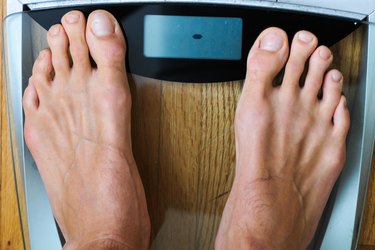
It can be difficult to have a sense of how your body is changing. The weight on the scale isn't necessarily an accurate measurement, and what you see in the mirror has a lot to do with your perception. Using accurate measurement tools will make it easier to track your progress.
Tip
Use the most accurate measurement you have available to you. Body fat calipers and bioelectrical impedance devices are user-friendly and widely available.
Video of the Day
Body Mass Index Is Flawed
One of the most well-known measurements for the human body is called body mass index (BMI). All you need is the height and weight of a person to find their BMI. In other words, it doesn't take into account how much muscle or fat you have, but just your weight relative to your height.
Video of the Day
Someone muscular can weigh more than a skinny person, relative to their height, but the person with more muscle might have less body fat. BMI isn't very useful for you as an individual, but it can be used on large populations. For example, a January 2019 study published in BMC Public Health used driver license data to calculate BMI for individuals living in Utah.
In this sense, BMI can be useful. A December 2018 study featured in Diabetes & Endocrinology and sponsored by the California Walnut Commission has found that people had a greater risk of mortality when their BMI rose above 25. Although it's useful as a tool for big populations, BMI isn't as helpful for individuals who want to figure out how much fat and muscle they have.
Determine Your Body Composition
Whether you're trying to get into the best shape of your life or you're simply trying to be a little healthier, tracking body composition is important. It's also the most challenging body metric to measure.
Your body composition is the amount of fat you have compared to your lean body mass. Bones, muscles, organs, tendons and ligaments are examples of lean body mass. There are also two different types of fat: subcutaneous and visceral.
Subcutaneous fat lies underneath the skin and around the belly, explains the University of Illinois, making it easier to measure. You can use body fat calipers or bioelectrical impedance to measure this kind of adipose tissue. Visceral fat surrounds your organs and it's more difficult to measure.
There are various tools you can use to measure body composition. Some are incredibly expensive and can only be found in hospitals or clinics. Others are cheaper and easy to use but may be inaccurate.
Of all the various methods for measuring body fat, three stand out as the gold standard: MRI, CT and DXA. A January 2017 study published in Nutrition & Diabetes suggests that DXA is slightly less accurate than MRI at measuring fat around the organs.
According to the above study, DXA may either overestimate or underestimate visceral fat mass based on the size of the subject. However, researchers note that DXA can be a viable alternative to MRI and CT scans for measuring body composition.
Magnetic resonance imaging, or MRI, has the added benefit of accurately measuring muscle mass, according to the study. Dual x-ray absorptiometry, or DXA, is also incredibly accurate and useful for determining your bone mineral density, according to the University of California, San Francisco.
Most Convenient Measurement Tools
While these may be the most accurate forms of measurement for body composition, they're inconvenient and not readily available. You'd most likely need to go to a hospital or clinic to use these methods, and it could be expensive. Most people need a more accessible option.
Alternative methods for measuring body fat can be fairly accurate as long as you know how to use them. A good example is the skinfold caliper. You use a small caliper to pinch fat at different sites on the body and then enter the numbers into an equation that estimates your overall body fat percentage.
While this is an archaic form of technology compared to other methods, it's still quite effective. In fact, a small study published in December 2019 in Wilderness & Environmental Medicine has shown that using skinfold calipers was equally as effective as something called "the Bod Pod," which is a technologically advanced and expensive piece of equipment.
- Wilderness & Environmental Medicine: "Assessing the Validity of Bioelectrical Impedance and Skinfold Calipers for Measuring Body Composition in NOLS Backcountry Hikers"
- University of California, San Francisco: "DXA/DEXA Beats BMI: Using an X-Ray Exam to Measure Body Composition & Fat Loss"
- University of Illinois: "Why Is Visceral Fat Worse Than Subcutaneous Fat?"
- Diabetes & Endocrinology: "The Association Between BMI and Mortality: Implications for Obesity Prevention"
- BMC Public Health: "Examining Validity of Body Mass Index Calculated Using Height and Weight Data From the US Driver License"
- Nutrition & Diabetes: "Validity of Visceral Adiposity Estimates From DXA Against MRI in Kuwaiti Men and Women"